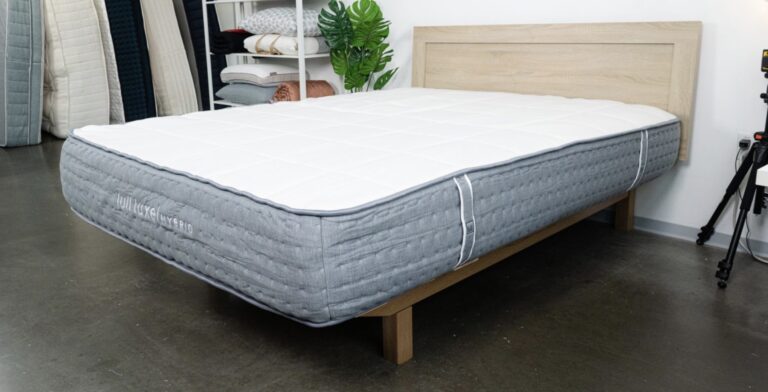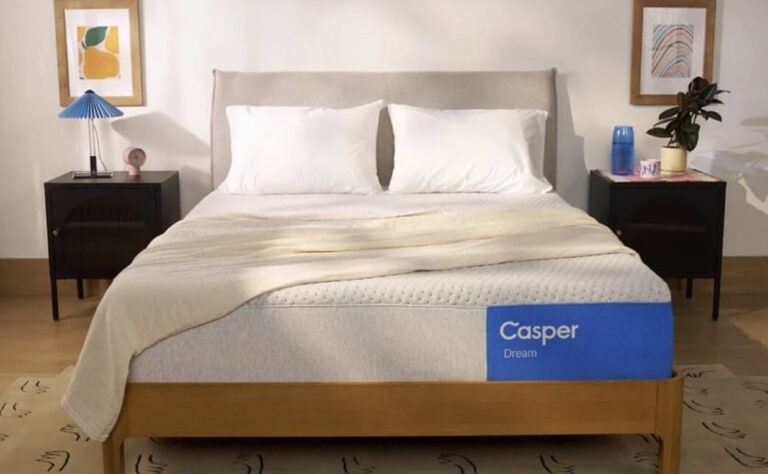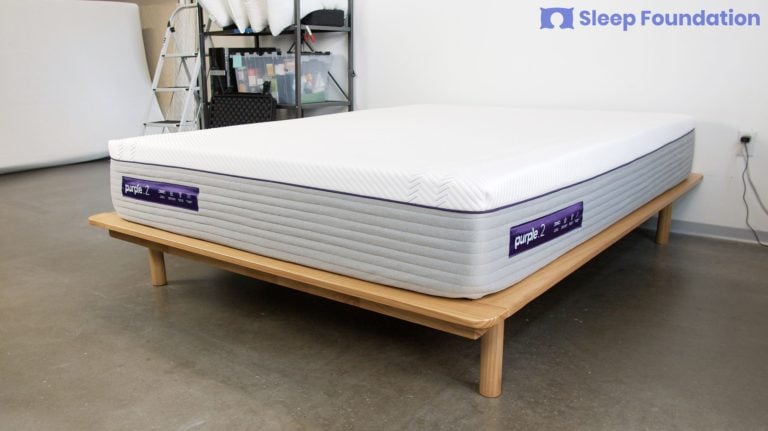When you buy through our links, we may earn a commission. Products or services may be offered by an affiliated entity. Learn more.
Puffy vs. Tuft & Needle Mattress Comparison
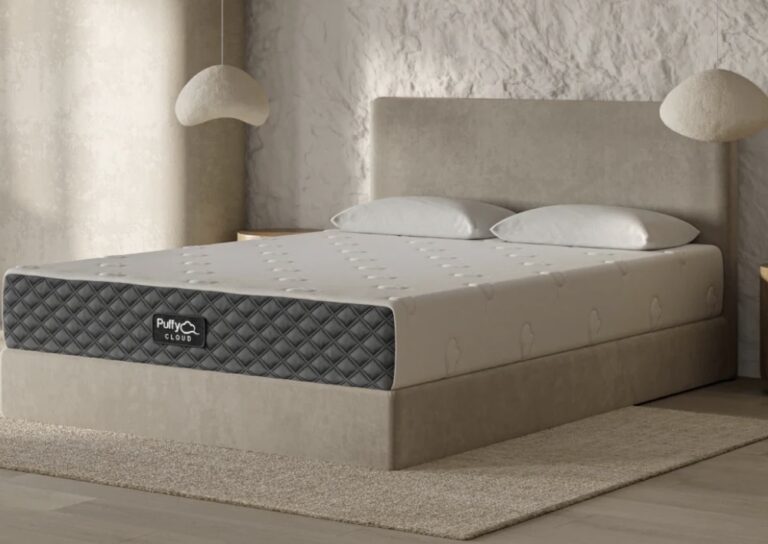
Puffy Cloud Mattress
Bottom Line
The Puffy Cloud mattress is an all-foam bed that uses memory foam to hug the body and take pressure off of common pain points.
$750 off + free accessories at Puffy
Full Mattress ReviewVS
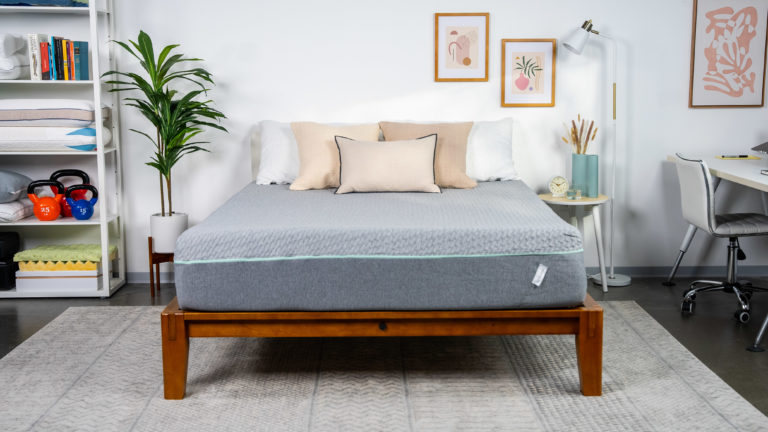
Tuft & Needle Original
Bottom Line
The Tuft & Needle Original is available in all-foam and hybrid options, with foams engineered to combat heat buildup and stay cool.
15% off mattresses
Full Mattress ReviewThere is a wide range of all-foam mattresses on the market, but many customers narrow down their search to models from Puffy and Tuft & Needle. These two manufacturers have garnered rave reviews, and their mattresses — particularly their flagship beds, the Puffy and the T&N Mattress — offer some of the best features found in all-foam models.
However, choosing between these two options can be difficult, as each is more or less suitable for different sleepers depending on their weight, preferred sleep position, and other factors.
Tuft & Needle is one of the oldest of the “mattress in a box” direct-to-consumer mattress companies. In addition to the T&N mattress, they offer the foam T&N Mint and the T&N Hybrid, which features a pocketed coil support core.
Puffy, on the other hand, entered the market more recently with their namesake flagship mattress. In addition to the Puffy Mattress, the company also sells the Lux Hybrid and Royal Hybrid, which feature the foam comfort and transitional layers and pocketed coils in their support cores.
While the T&N and Puffy mattresses share some similarities, they also have substantial differences. We’ll compare and contrast both companies and their mattresses to help you decide which is more suitable for your needs.
Quick Look
$1,049 – $2,399
$995 – $1,995
Medium (5)
Medium (5), Medium Firm (6)
- Deep contouring from gel-infused memory foam
- Significant motion isolation
- Lifetime full replacement warranty
- Balanced feel with moderate contour and bounce
- Open-cell and infused foam resists heat buildup
- Affordable price-point
- 101 Nights (14-night requirement)
- Lifetime, Limited
- 100 nights
- 10-Year, Limited
- A+
- A+
Sizing and Weight Options
Deciding on what size of bed works best for you is an essential part of buying a new mattress. Most companies tend to offer a similar range of mattress sizes. Still, many do not provide more unusual sizes (such as king size variants beyond California), and only some offer split sizes. Depending on what dimensions you need, this may make a significant impact on your decision.
Height and weight, while less critical than size, are also crucial considerations. Beds with a higher profile tend to be more expensive, but may also be more appropriate to your needs. This is particularly true for sleepers who weigh more than 230 pounds, who may sink too far into low-profile beds.
Weight primarily matters when setting up or moving your bed, as very heavy mattresses can be cumbersome to move. Bulky mattresses may also exceed bed frame weight ratings when combined with a sleeper’s body weight.
Puffy
Tuft & Needle
Height
10″Size Options
Twin, Twin XL, Full, Queen, King, California King, Split KingHeight
9.5?Size Options
Twin, Twin XL, Full, Queen, King, California KingHeight
12″Size Options
Twin, Twin XL, Full, Queen, King, California King, Split KingHeight
12″Size Options
Twin, Twin XL, Full, Queen, King, California KingHeight
14″Size Options
Twin, Twin XL, Full, Queen, King, California King, Split KingHeight
12″Size Options
Twin, Twin XL, Full, Queen, King, California KingWhen comparing the mattress options from both Puffy and Tuft & Needle, it becomes apparent that they are quite similar. Both companies share the same standard list of available size options. Puffy offers a split king size as well. They also offer similar ranges, with lower-profile flagship mattresses in addition to heavier luxury options with higher profiles.
Both T&N’s hybrid and luxury foam beds come in at 12 inches, 2 inches taller than their flagship mattress. Puffy goes a step further, with the Puffy Royal Hybrid measuring 14 inches high. This increased thickness also affects the bed’s weight, and this model is even heavier due to its pocketed coil support core.
While customers in search of rarer sizes or extra-thick low-cost options may be disappointed, both Puffy and Tuft & Needle offer a reasonable range of options that are likely to please the majority of sleepers.
Construction and Materials Comparison
Comparing the way mattresses are made is an important step, even when the beds in question appear on the surface to be very similar. Although the Puffy Original and the T&N Original both feature an all-foam design, the types of foams used, the thickness of individual layers, and their overall construction vary in some crucial ways.
There are two major considerations to keep in mind when looking at mattress construction. The first is the impact that certain construction choices have on how it feels to sleep on a bed. For example, an all-foam bed with low-density memory foam in its comfort system will feel significantly different than a similar bed with a high-density polyfoam comfort layer.
Secondly, a bed’s construction and the quality of its materials also have a significant impact on how a bed performs in a wide variety of important areas, such as durability, edge support, and temperature neutrality. Understanding a bed’s construction is the first step in determining how well it performs.
Puffy
Puffy has made its name for itself by offering an all-foam bed that combines exceptional pressure relief with full-body support. This is made possible by its overall design, but it is this same design that makes it less appropriate for some sleepers.
At 10 inches high, the Puffy is the same height as the T&N Original but slightly thinner than many competitors. Its 100% polyester cover is soft and stretchy, as well as being stain-resistant. (The cover can also be unzipped for more thorough washing.)
A bed’s comfort system plays a significant role in how it feels, and the Puffy’s resilient pressure relief is the result of its two comfort layers. The first is 2 inches of low-density memory foam, which feels extra-soft and cradles the body to prevent uncomfortable pressure points. This layer is also gel-infused, which is thought to improve temperature neutrality for a cooler sleep.
Next, the Puffy has a 2-inch layer of temperature-resistant polyfoam. This layer provides the bed’s sleep surface with slightly more responsiveness than it would have with memory foam alone. The polyfoam also works as a transition layer, preventing sleepers from sinking against the firm support core.
The support core is 6 inches high and made from high-density polyfoam. This is standard in most all-foam beds, and high-density polyfoam offers good stability and support for many sleepers. However, it lacks the horizontal strength of innerspring and pocketed coil cores, making edge support and durability potential concerns.
In addition to the Puffy, the company also offers the all-foam Puffy Lux and Puffy Royal models. These are thicker than the Puffy — 12 inches and 14 inches, respectively — thanks to their thicker comfort and support layers.
The Puffy Lux Hybrid has improved support due to a dedicated polyfoam transitional layer. The memory foam layer is an inch thicker and the support core contains pocketed coils, making for a more plush-feeling sleep surface and a more durable design overall. The coil system also offers the Lux Hybrid better edge support when compared to the Puffy.
The company’s most expensive all-foam model is the Puffy Royal Hybrid, which matches its higher cost with an extra-thick profile and even more comfort and support layers. This luxury mattress has a deep comfort system, utilizing gel memory foam, standard memory foam, and temperature-resistant polyfoam. Together, these layers provide better temperature regulation and bouncier support than the Puffy or Lux models. They are followed by a transitional layer of convoluted memory foam, as well as the support core’s 6-inch pocketed coils and 1-inch layer of base polyfoam.
Tuft & Needle
The T&N Original was designed to offer excellent performance at a surprisingly low price, and its design reflects this ethos. The bed is the same thickness as the Puffy, at 10 inches, but its overall construction clearly shows areas where the two mattresses differ.
To begin with, the T&N Original’s cover is a stretchy blend of polyester and polyamide. Both are artificially made fabrics, but they have different properties: polyester is more stain-resistant than polyamide and less prone to pilling. In contrast, polyamide is extra soft to the touch and has stronger, more flexible fibers. Together, the two fabrics wick away sweat (thanks to the polyester) and breathe easily, while staying soft and comfortable.
Unlike the Puffy, the T&N Original’s cover is integrated and not removable for cleaning. The Mint’s cover features an additional antimicrobial protectant, and the top half of the cover can be zipped off and machine washed. These two features are unique to the Mint and not found on the other T&N mattresses.
The T&N Original has a single, 3-inch-thick comfort layer. Made from low-density polyfoam, it feels soft and pressure-relieving but is slightly springier and more resilient than memory foam. To combat synthetic foam’s tendency to retain heat, the T&N Original’s comfort system features infusions of both gel and graphite, both of which are thought to improve temperature neutrality and promote better airflow.
Seven inches of high-density polyfoam provide a stable and relatively supportive core to the T&N Original. As is true with the majority of all-foam beds, the T&N Original’s core does not offer the same edge support or overall durability as a hybrid model. However, it is likely to satisfy the majority of sleepers and allows for the T&N Original’s low cost.
In addition to the T&N Original, Tuft & Needle also offers the T&N Mint and the T&N Hybrid.
The all-foam T&N Mint builds on the T&N Original’s overall design but adds an extra 2 inches of height with a transitional layer of gel-infused polyfoam. This difference makes the Mint more supportive than the T&N Original, as well as more durable. However, their performance is otherwise quite similar, as there is little variation between the T&N Original and the Mint.
Tuft & Needle’s hybrid model, on the other hand, is significantly different from the T&N Original and the Mint. Its comfort system consists of three distinct layers: 2 inches of graphite and gel-infused memory foam, 1 inch of springy microcoils, and another inch of adaptive polyfoam. Instead of high-density polyfoam, its support core features 6 inches of pocketed steel coils and a final 1-inch layer of high-density polyfoam to provide overall stability.
This design makes the Hybrid more responsive and supportive than the T&N Original or Mint, though with less pressure relief than either of the all-foam options.
In-Depth Ratings
Our testing process involves grading each mattress in eight critical categories. Each sleeper has different wants and needs when buying a mattress, and these categories allow our readers to better understand which bed is right for them.
Despite their similarities, Puffy and Tuft & Needle scored differently in our tests. The Puffy scored lower than the T&N Original overall, though it earned higher scores in some important areas. This trend continued through their other mattress lines.
Durability
All mattresses have an expected lifespan, after which point they should be replaced. However, some beds will begin showing their age far sooner than other options. Less durable all-foam beds, for example, may feel softer after several years than they do upon purchase. Durability is usually rated based on a combination of what we know about its construction and the quality of materials used, as well as reports from verified owners.
Motion Isolation
Few couples want to sleep on a mattress that allows them to feel any time their sleep partner rolls over, changes position, or gets out of bed. We judge this category on how well a bed suppresses and isolates movement, making it important for couples but less crucial for single sleepers. In general, all-foam mattresses tend to perform well in this category thanks to their high point elasticity.
Sex
As with the previous category, a mattress’s suitability for sex may or may not be an important consideration. We grade beds on their suitability based on a range of factors, including how well it performs in terms of motion isolation, ease of movement, edge support, and bounciness and responsiveness. All-foam beds tend to perform less well here than models with more bounce and lower point elasticity.
Temperature Neutrality
Mattresses can trap heat, making for an uncomfortably hot and clammy sleep experience. On the other hand, those that are temperature-neutral allow for proper airflow and a more comfortable night in bed. All-foam beds can score poorly here due to their solid support core and the poor airflow associated with most synthetic foams. Manufacturers often remedy this by using unique foams (such as gel foams or those infused with other materials), which are thought to be more temperature neutral.
Pressure Relief
This category rates how well a mattress prevents pressure points and provides a pressure-free cradle to prevent next-day stiffness or soreness. Mattresses can score well here regardless of their firmness or construction, but all-foam mattresses are known to have some of the best performance in this category. Most people want some pressure relief, and high-scoring mattresses may be some of the most attractive to people with chronic pain or stiffness.
Off-Gassing
The smell of a new mattress is like the smell of a new car: distinctive, temporary, and the result of compounds created in the manufacturing process. In all-foam beds, these take the form of volatile organic compounds (VOCs), which are mostly harmless but can smell quite strong. Luckily, VOCs degrade and vanish quickly in most cases. This category ranks a mattress on both how strong its initial odor is and how quickly it takes to dissipate.
Ease of Movement
Depending on a mattress’s construction, moving around on its surface can feel easy or as though you’re trying to move through water. In many cases, this is a matter of a personal choice, with many sleepers preferring one or the other. However, ease of movement can be very important for people with mobility concerns, as well as making a bed more suitable for sex. In general, very conforming beds tend to score lower here than bouncier, more responsive models.
Edge Support
Most beds are less supportive at their perimeter than they are closer to their center. This category rates this important quality, examining how supported people feel when sleeping close to the edge, as well as whether the bed dips significantly when sitting on the edge. Couples often desire a bed with good edge support, as it allows them to make use of the mattress’s entire sleeping surface. People with mobility concerns may also find this category relevant, particularly those who struggle when getting into or out of bed.
Puffy
Sleep Foundation Special Offer
$750 off + free accessories at Puffy
Tuft & Needle
Sleep Foundation Special Offer
15% off mattresses
In-Depth Pricing
Price is deeply important to most people looking for a new mattress. While it may be tempting to assume that a more expensive bed will outperform a less expensive competitor, this is often false. There are many exceptional beds available at budget prices, making it essential to carefully examine how a mattress performs in a range of categories rather than relying on its price tag.
Many factors can influence a mattress’ price. The first and most important is its construction: all-foam beds tend to be less expensive than hybrid models with pocketed coils, for example, and natural latex is more costly than synthetic foams. The quality of materials also plays a part, as does the complexity of the bed’s design. Thicker beds also tend to cost more, as they are made with more material.
However, the cost of a mattress can also be influenced by factors that have nothing to do with its quality or performance. For example, direct-to-consumer mattress brands tend to have lower prices than traditional showroom companies, as they are able to avoid the costs of brick-and-mortar stores. Companies that advertise heavily will also pass that cost along to their customers.
It’s possible to find an excellent mattress at every price range, but it’s important to research what is best for you before making a decision.
While both Puffy and Tuft & Needle offer both lower-priced options and luxury models, there are significant differences in their pricing strategies. This is most apparent when comparing their flagship mattresses, as the T&N Original is less expensive than the flagship Puffy. The trend continues through their deluxe options —Tuft & Needle’s Mint mattress costs only slightly more than the T&N Original, whereas the Puffy Lux Hybrid and Royal Hybrid have luxury mattress pricing.
The T&N Hybrid is an outlier, given that pocketed coils tend to cost more than foam support cores. While more expensive than the company’s all-foam options, it is still lower-priced than many hybrid competitors.
For many people, the low price of the T&N Original will make it more appealing than the Puffy. However, it’s still important to ensure you choose the right mattress for your needs. If both fall within your budget, one may be more suitable for you than the other, regardless of price.
Trial, Warranty, and Delivery
Puffy
Sleep Trial & Returns
101 Nights (14-night requirement)
Warranty
Lifetime, Limited
Shipping
Free to all 50 states
Tuft & Needle
Sleep Trial & Returns
100 nights
Warranty
10-Year, Limited
Shipping
Free to contiguous U.S.
Shipping
Puffy ships its mattresses throughout the U.S. and Canada. Shipping is free for customers throughout all 50 states. (This fee is non-refundable when returning a mattress.) All shipments are made through FedEx, and you will be provided with a tracking number when your mattress is sent to you. After making your purchase, you can expect your new Puffy mattress to arrive within two to five business days.
Tuft & Needle ships throughout the U.S., though not to Canada. Customers in the contiguous states receive free shipping, while those in Hawaii or Alaska must pay a fee that usually ranges from $120 to $200 depending on location. The company ships through FedEx Ground, which supplies customers with tracking data. (Most Tuft & Needle mattresses arrive within three to seven business days of purchase.) Same-day delivery is available for $50 in some zip codes of New York City, Chicago, Phoenix, Los Angeles, San Francisco, and Seattle. These orders must be placed before 3:45 PM local time and are usually delivered between 4:30 and 9:30 PM.
White Glove Delivery
Some mattress companies offer White Glove delivery, which usually involves mattress specialists coming to your home to set up your new mattress and remove your previous mattress if needed.
While Puffy does not offer White Glove delivery or old mattress removal, Tuft & Needle offers both for customers in the contiguous U.S. For a non-refundable, $150 fee, the company will send a team to ensure your new mattress is set up perfectly, and will take away your former mattress for recycling or disposal if desired.
Sleep Trial & Returns
Most direct-to-consumer mattress companies offer sleep trials to ensure their customers feel comfortable purchasing a mattress they’ve never tested. These allow you to sleep on your new mattress before deciding whether or not to keep it, giving you a better idea of how it performs than the traditional showroom experience. As it can take several weeks to adjust to a new mattress, some companies require a “break-in period” before returns are accepted.
Puffy offers its customers a 101-night sleep trial with a 14-night break-in period, though they encourage customers to wait 30 days before making a decision. After two weeks have passed, customers can return the mattress for a full refund, minus any shipping fees. (Returned mattresses are donated whenever possible.) The sleep trial is only valid for purchases made through the official Puffy website, and returns are limited to two per household, with one return permitted per year.
Tuft & Needle features a 100-night sleep trial with no initial break-in period. Customers who return their mattress receive a full refund, minus any shipping or White Glove delivery fees. Those who are happy with the company but not their new mattress may also choose to exchange their choice for another model rather than receive a refund, though they must pay any price difference. Tuft & Needle encourages customers to donate or recycle their returned mattress but will arrange for the mattress to be picked up if necessary. One return is allowed per household, per year.
Warranties
Most mattresses are covered by a manufacturer’s warranty. These usually cover similar problems, though their length and terms vary between companies.
Puffy offers a lifetime, non-prorated warranty with all of its mattresses. This covers visible impressions or foam sagging deeper than 1.5 inches, as well as flaws or manufacturing defects in the mattress’s cover or the cover’s zipper. Normal wear-and-tear and owner damage are not covered, nor are personal preference changes or the development of allergies or sensitivities. The warranty is not considered valid if the mattress is sold or given away, and is voided by improperly supporting the mattress. If your mattress does develop one of the covered problems, Puffy will replace your mattress with the most similar current model in the same size. Replacement models are also covered under a lifetime warranty.
Tuft & Needle’s mattress warranty lasts for ten years and is non-prorated. Lingering indentations 0.75 inches or deeper are covered, as are manufacturing defects and physical flaws in the mattress foam or cover. Owner damage, ordinary wear-and-tear, and indentations shallower than 0.75 inches are not covered. The warranty is non-transferable and is considered void if your mattress is not supported according to Tuft & Needle’s instructions. Should your mattress develop any of the covered problems within ten years of purchase, Tuft & Needle will either repair or replace your mattress at their discretion.

Still have questions? Ask our community!
Join our Sleep Care Community — a trusted hub of product specialists, sleep health professionals, and people just like you. Whether you’re searching for the perfect mattress or need expert sleep advice, we’ve got you covered. Get personalized guidance from the experts who know sleep best.

